- Courses
- GS Full Course 1 Year
- GS Full Course 2 Year
- GS Full Course 3 Year
- GS Full Course Till Selection
- Essay Target – 150+ Marks
- Online Program
- GS Recorded Course
- NCERT (Recorded 500+ Hours)
- Polity Recorded Course
- Geography Recorded Course
- Economy Recorded Course
- AMAC Recorded Course
- Modern India, Post Independence & World History
- Environment Recoded Course
- Governance Recoded Course
- Science & Tech. Recoded Course
- International Relations and Internal Security Recorded Course
- Disaster Management Module Course
- Ethics Recoded Course
- Current Affairs Recoded Course
- CSAT
- 5 LAYERED ARJUNA Mentorship
- Public Administration Optional
- ABOUT US
- OUR TOPPERS
- TEST SERIES
- FREE STUDY MATERIAL
- VIDEOS
- CONTACT US
PLACES IN NEWS 14th DECEMBER 2024
PLACES IN NEWS 14th DECEMBER 2024
14-12-2024
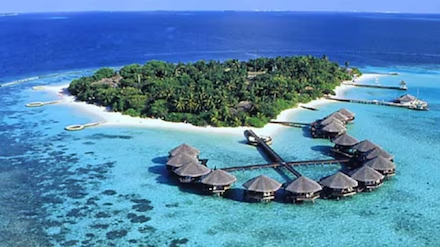
Zaporizhzhia
Why in news?
- The Zaporizhzhia region has established robust defence lines with circular city protection, heavily supporting military units with drones, vehicles, and communication tools.
- President Zelensky urged replicating Zaporizhzhia's defence funding and patronage model in regions bordering Russia.
About Zaporizhzhia:
- The Zaporizhzhia region is located in southeastern Ukraine and holds strategic significance in the ongoing Russia-Ukraine war.
- It connects central Ukraine to the Sea of Azov and hosts key infrastructure, including the Zaporizhzhia Nuclear Power Plant.
- The region's geography comprises steppes, rivers, and industrial zones, making it critical for logistics and defence.
- The Dnieper River, running through it, provides a natural barrier against invasion.
- Its proximity to Russian-occupied areas, like Crimea and parts of Donetsk, has made it a focal point for artillery duels, missile strikes, and ground offensives, with cities like Orikhiv and Zaporizhzhia facing significant damage.
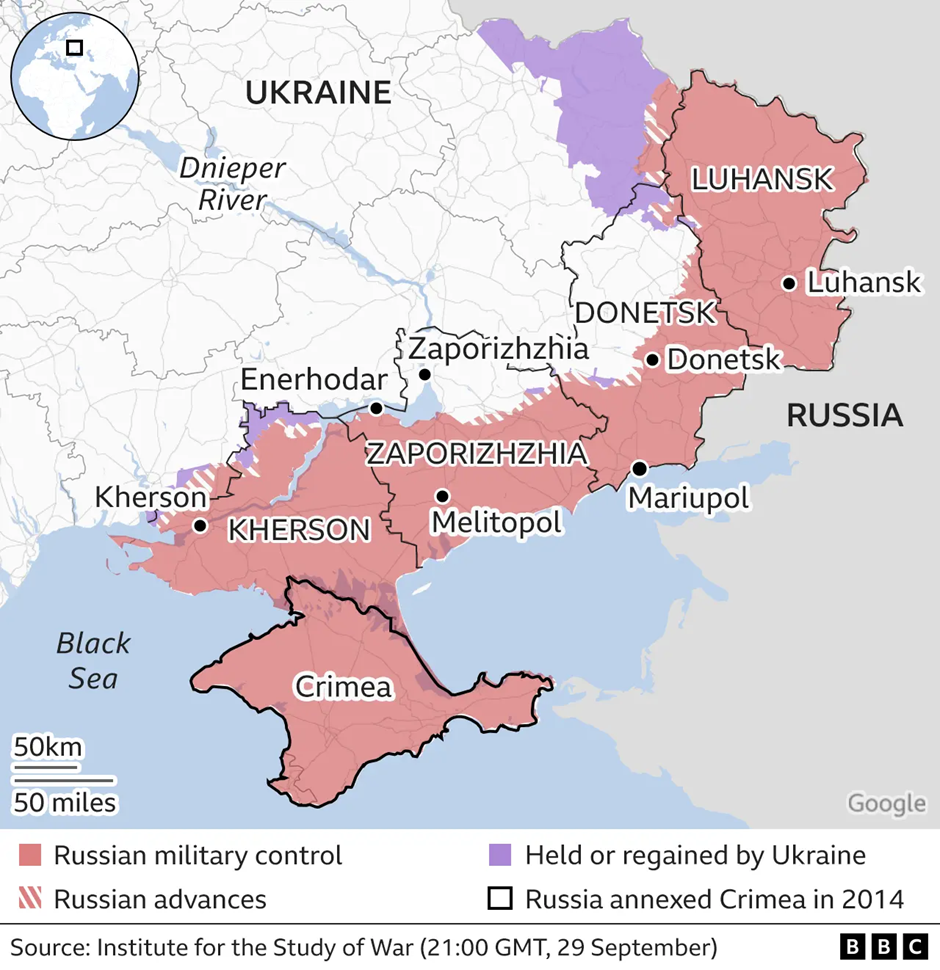
About Russia-Ukraine war:
- Background:
- The war began after Russia massed troops along Ukraine’s borders in February 2022, citing North Atlantic Treaty Organisation (NATO) expansion as a perceived threat to its security.
- This marked an escalation of tensions that had been building since 2014, when Russia annexed Crimea and actively instigated conflict in Ukraine's Donbas region (Donetsk and Luhansk) by supporting separatist movements.
- These actions were fuelled by Moscow's opposition to Ukraine’s pivot towards the West, which was symbolised by its aspirations to join the European Union (EU) and strengthen ties with NATO, furthering the rift with Russia and deepening the geopolitical rift.
- Key regions affected:
- Donetsk and Luhansk: These eastern regions, collectively known as the Donbas, have seen intense fighting as Russia seeks to solidify control. Urban centres like Bakhmut and Avdiivka have been battle hotspots.
- Zaporizhzhia: Strategically significant for its nuclear power plant and position near the Dnieper River, it has faced shelling and acts as a key frontline.
- Kherson: This southern region was initially occupied by Russia but has been partially liberated by Ukrainian forces. Control here is critical for access to the Black Sea and Crimea.
- Kharkiv: Located near the Russian border, this northeastern city has endured heavy bombardments but remains under Ukrainian control.
- Kyiv: The capital was an early target for Russia, aiming to overthrow Ukraine’s government. However, Ukrainian resistance repelled Russian forces, marking a pivotal moment in the war.
- Mykolaiv and Odesa: Vital port cities in the south, critical for Ukraine's economic connectivity and grain exports, have been targeted by missile strikes.
- Current situation:
- The war remains intense, with heavy fighting concentrated in eastern and southern Ukraine, especially in Donetsk, Luhansk, Zaporizhzhia, and areas near Bakhmut.
- Russia continues launching missile and drone strikes targeting Ukraine's energy infrastructure and civilian areas.
- Ukraine has mounted successful counteroffensives, regaining territories such as Kherson and pushing Russian forces back in parts of the Donbas.
- International military aid, including advanced weaponry systems from the West, has bolstered Ukraine’s defence.
Debrigarh Wildlife Sanctuary
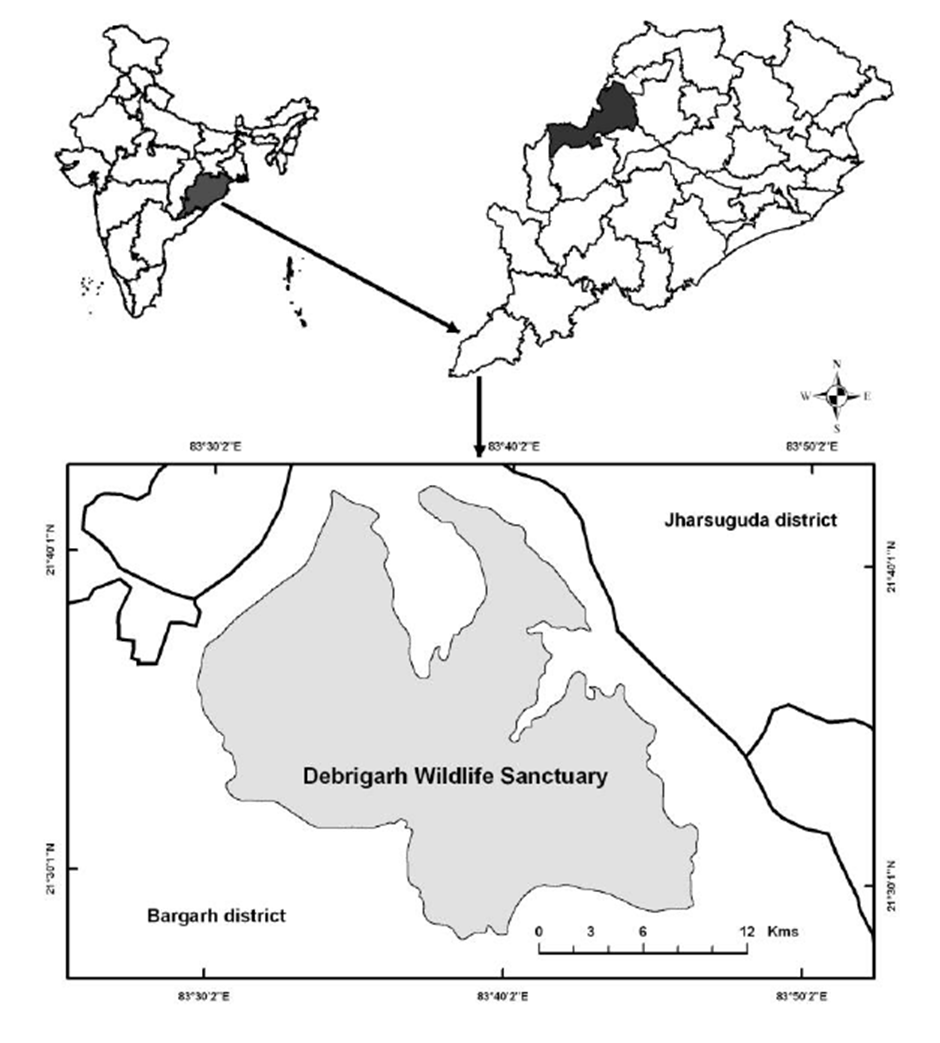
Why in news?
-
- At Debrigarh Wildlife Sanctuary, the first-ever census of Indian bison (guar) was conducted, which recorded 659 individuals with 30% juveniles, indicating a growing population.
About Debrigarh Wildlife Sanctuary:
- Debrigarh Wildlife Sanctuary is located in western Odisha, near the Hirakud Reservoir, which is located in the Mahanadi River, covering hilly terrain interspersed with valleys, plains, and over 60 seasonal and perennial nullahs and streams.
- Flora:
- The sanctuary boasts a mix of dry deciduous forests, grasslands, and meadows, which provide primary nutrition for herbivores like the Indian bison (gaur).
- The area is rich in grasses, bamboo, and a variety of forest trees like sal and teak, forming a robust ecological foundation.
- Fauna:
- Debrigarh is home to several Schedule-1 species under the Wildlife Protection Act, 1972, including the Indian bison, which thrives due to the nutritious meadows.
- Other prominent species include leopards, sloth bears, and sambars, along with smaller carnivores and herbivores. The sanctuary also supports rich avifauna, with various migratory and resident bird species due to its proximity to water bodies.
About Indian Bison (Guar):
- The Gaur (Bos gaurus), also known as the Indian Bison, is the largest and tallest wild cattle species in the world, reaching heights of up to 2.2 meters at the shoulder and weighing between 700 and 1,500 kilograms.
- Both sexes have curved horns, but males are significantly larger and more robust.
- Gaurs are social animals, typically forming herds of 8 to 30 individuals, led by a dominant female.
- Distribution:
- Gaurs are found in South and Southeast Asia, with populations in India, Nepal, Bhutan, Bangladesh, Myanmar, Thailand, Cambodia, Laos, Vietnam, and Malaysia.
- In India, their primary habitats include the Western Ghats, Eastern Ghats, central Indian forests, and parts of the Northeast.
- They inhabit a range of ecosystems, including tropical moist forests, deciduous forests, and grasslands, thriving in areas with ample water and grazing resources.
- Conservation Status:
- the Guar is listed as Vulnerable on the IUCN Red List that faces threats from habitat loss, fragmentation, poaching, and diseases transmitted by domestic cattle.
- It is protected under Schedule-1 of the Indian Wildlife Protection Act, 1972. Conservation efforts include habitat restoration, anti-poaching measures, and eco-sensitive zone declarations around sanctuaries.
Sea of Marmara
Why in news?
- An outbreak of marine mucilage, or sea snot, has spread across Turkey’s Sea of Marmara, threatening marine life and the fishing industry.
- The outbreak has been caused by pollution and climate change, which are affecting the aquatic ecosystem by depleting the oxygen levels.
About Sea of Marmara:
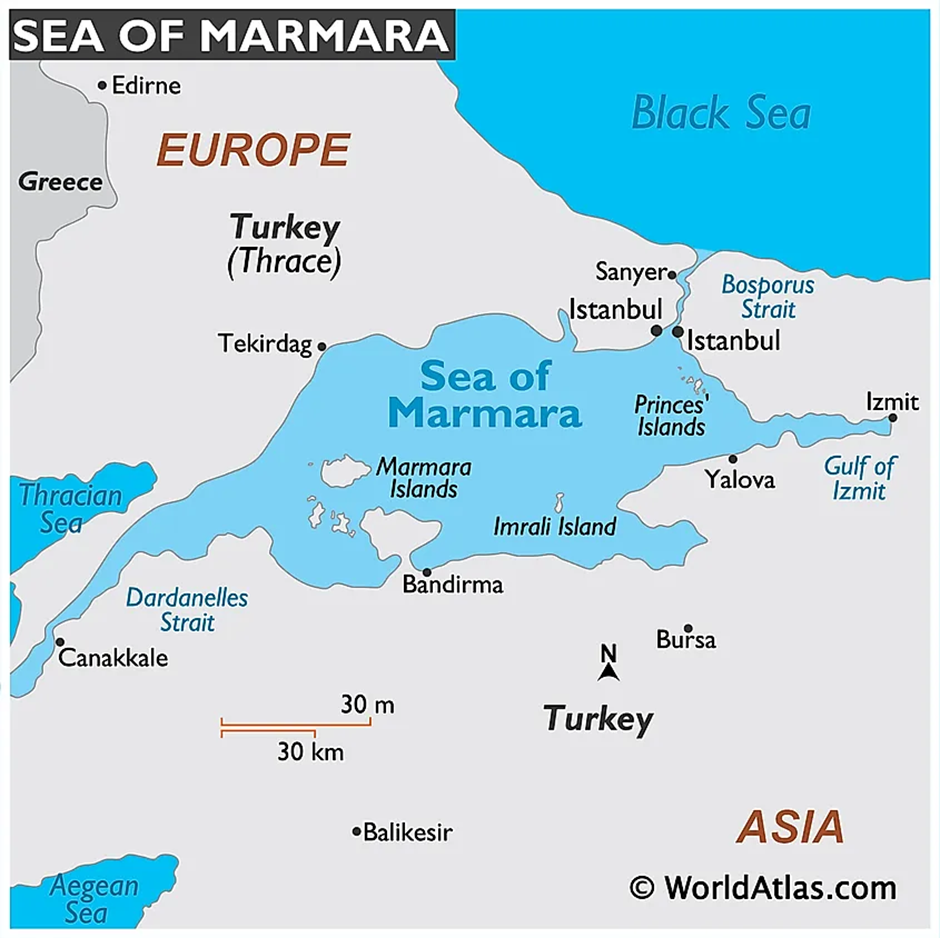
- Geography:
- The Sea of Marmara lies entirely within Turkey, connecting the Black Sea to the Aegean Sea via the Bosphorus and Dardanelles Straits, respectively.
- It covers about 11,350 square kilometres with a maximum depth of 1,370 meters.
- The Marmara acts as a natural boundary separating Europe and Asia, hosting numerous islands like Princes' Islands and Marmara Island.
- Natural Resources:
- The sea is rich in marine biodiversity, including fish species like anchovies, mackerel, and bluefish, which support local fishing industries.
- Beneath its waters lie significant natural gas and oil reserves, particularly in its deeper regions, contributing to Turkey's energy exploration efforts.
- Additionally, the surrounding areas are abundant in marble quarries, especially on Marmara Island, which has historically supplied high-quality marble for architecture and sculpture.
- Geopolitical significance:
- The Sea of Marmara holds critical geopolitical importance due to its location on key shipping routes that connect the Mediterranean and Black Sea.
- It is part of the Turkish Straits, which is a globally strategic waterway for trade, energy transportation, and naval operations.
- The region has been central to Turkey’s maritime sovereignty and disputes over Montreux Convention regulations, which govern access to the straits.
What are Sea snots?
- Sea snot, scientifically known as marine mucilage, is a thick, slimy organic substance composed of compounds released by marine organisms, primarily phytoplankton.
- This mucilage forms when these microorganisms grow excessively in nutrient-rich environments, often exacerbated by factors such as pollution, climate change, and warmer sea temperatures.
- The substance is typically made up of microorganisms, proteins, carbohydrates, and fats, and it can blanket the sea’s surface or sink to the seabed.
- This layer blocks sunlight, depletes oxygen, and disrupts marine ecosystems, suffocating marine life and damaging industries like fishing and tourism.
- Outbreaks are linked to sewage runoff, agricultural waste, and rising sea temperatures, all of which provide excessive nutrients for algae growth.
- The Sea of Marmara in Turkey experienced one of the largest recorded outbreaks in 2021, drawing global attention to the impacts of unchecked environmental degradation.
Lakshadweep Islands
Why in news?
- The Ministry of Earth Sciences informed Lok Sabha that 84.6% of Lakshadweep's coral reefs experienced bleaching during the Fourth Global Coral Bleaching Event (GCBE4).
About Lakshadweep islands:
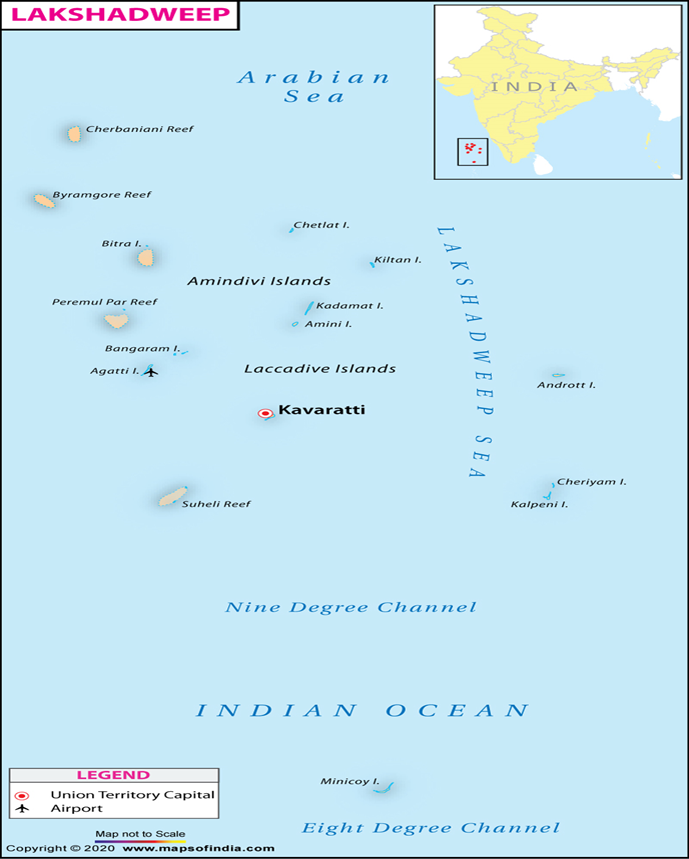
- Lakshadweep is India’s smallest Union Territory, comprising 36 islands, including 10 inhabited islands, 17 uninhabited islands, and several atolls and reefs, which is spread over 32 sq km of land area.
- The islands are located in the Arabian Sea, about 200-400 km off the southwestern coast of India.
- The archipelago is formed entirely of coral atolls and reefs, making it a globally significant marine ecosystem.
- These islands are surrounded by lagoon ecosystems, covering approximately 4,200 sq km, which provide vital habitats for a variety of marine species.
- The coral reefs of Lakshadweep are among the most biodiverse ecosystems in India, supporting numerous species of fish, crustaceans, and molluscs, as well as endangered species like sea turtles and dugongs.
- Lakshadweep’s reefs act as natural barriers, protecting the islands from coastal erosion and extreme weather events like cyclones and storm surges.
- The islands are an important part of the Indian Ocean’s marine ecosystem, contributing to carbon sequestration and regulating the ocean’s health.
- Lakshadweep is a key fishing zone, sustaining the livelihood of local communities by providing rich marine resources, particularly tuna.
What is Fourth Global Coral Bleaching Event (GCBE4)?
- The Fourth Global Coral Bleaching Event (GCBE4) is a widespread coral bleaching phenomenon caused by elevated sea temperatures, particularly due to marine heatwaves linked to climate change and El Niño events.
- The event was declared by the National Oceanic and Atmospheric Administration (NOAA) in 2023, which has severely impacted coral reefs worldwide, including the Indian Ocean, Pacific Ocean, and Atlantic Ocean basins, with regions like Lakshadweep, Andaman and Nicobar Islands, and Gulf of Mannar in India experiencing extensive bleaching.
- The event began in mid-2023 and is ongoing, marking the second global bleaching event within the last decade.
- Previous Global Coral Bleaching Events:
- First Global Coral Bleaching Event (1998)
- triggered by the intense 1997-1998 El Niño, combined with climate change.
- It caused mass bleaching in nearly 75% of reefs worldwide, with about 16% of global coral cover lost.
- The event existed for approximately one year, peaking between 1997 and 1998.
- Second Global Coral Bleaching Event (2010)
- Extensive bleaching across 60 countries, especially in the Indian and Pacific Oceans.
- happened for the period of six months to one year.
- Third Global Coral Bleaching Event (2014-2017)
- Unprecedented sea surface temperature rise linked to prolonged El Niño and La Niña conditions.
- It was the longest-lasting event, which affected more than 90% of reefs globally, with 30% of reefs suffering permanent damage.
- The event existed for nearly three years, from mid-2014 to mid-2017.
- First Global Coral Bleaching Event (1998)
UPSC CSE PYQQ1. Consider the following pairs:
Answer: Option D |




